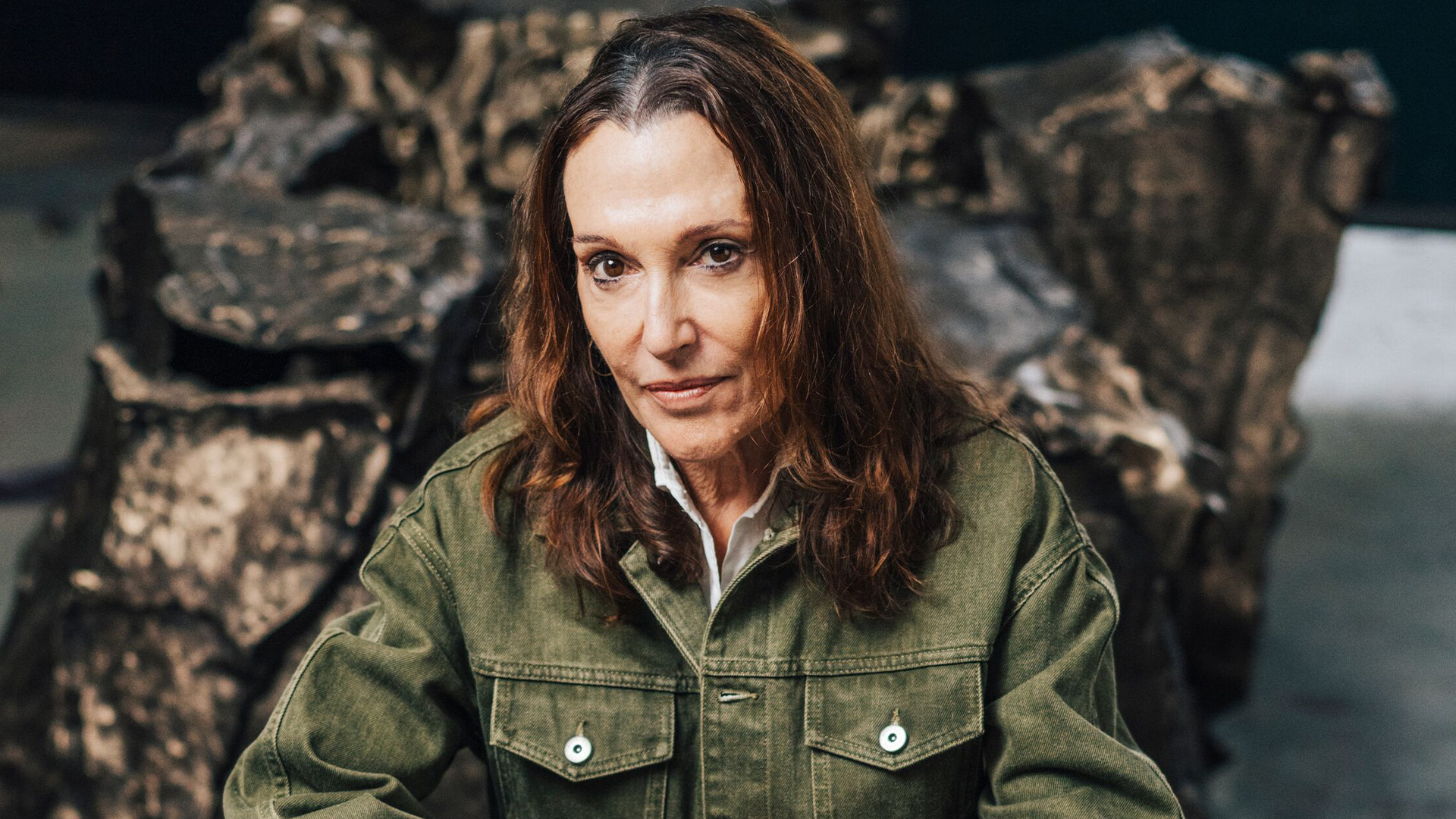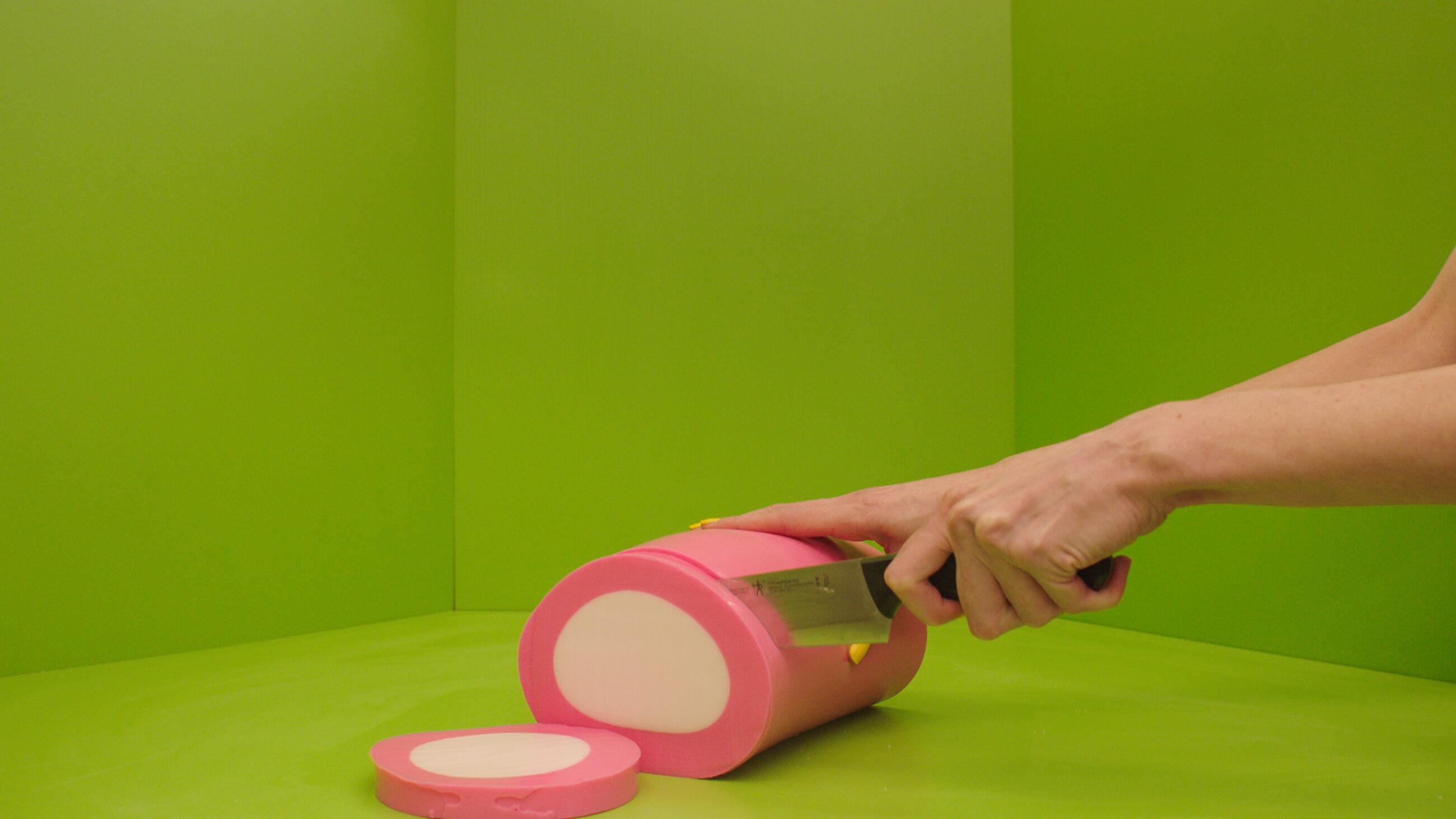Exhibition Learning Notes: ‘Cristina Iglesias. The Shore’
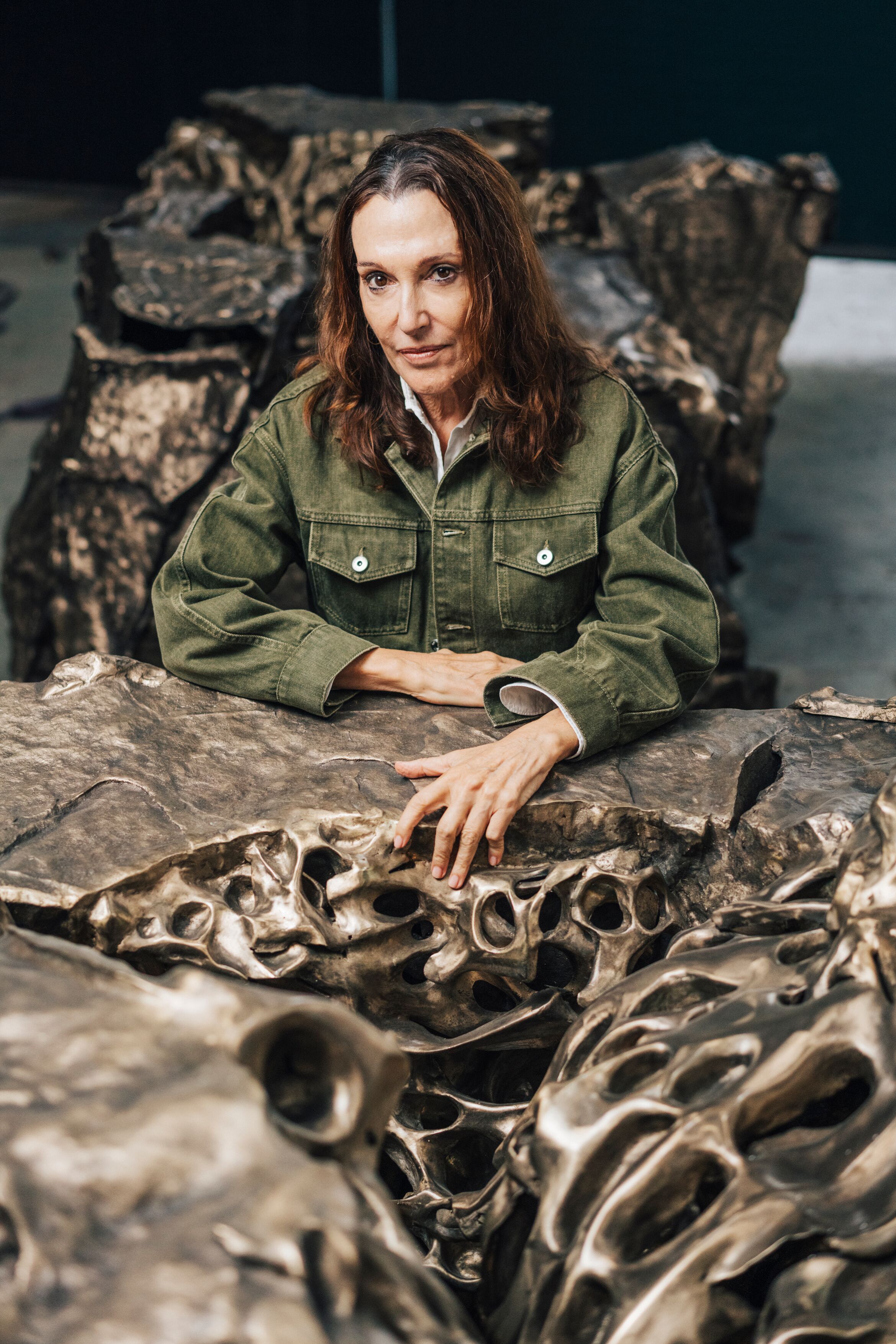
Cristina Iglesias, 2025 © Cristina Iglesias, VEGAP, Barcelona, 2025. Photo: Álex Iturralde
Exhibition Learning Notes: ‘Cristina Iglesias. The Shore’
This resource has been produced to accompany the exhibition ‘Cristina Iglesias. The Shore’ at Hauser & Wirth London from 14 October to 20 December 2025.
About Cristina Iglesias
Cristina Iglesias (b. 1956, Donostia San Sebastián, Spain) has over four decades of work, creating environments that merge art, nature, architecture and literature. She studied chemical sciences at the University of the Basque Country, then ceramics and drawing in Barcelona, before moving to London in 1980 to deepen her experimentation. Her process has always been interdisciplinary, combining conventional sculptural materials (iron, steel, bronze, glass) with less traditional ones like water and sound. Iglesias’ works often carve out forms that feel architectural—walls, archways, enclosures or shelters—but they also engage deeply with the natural world—vegetation textures, rocklike surfaces, the flow of water, subterranean spaces and geological time.
What does the exhibition look like?
‘The Shore’ comprises of three large bronze sculptures that could resemble meteorites, each with a rough, porous surface and rocklike lustre. They are placed to evoke the meeting of land and water—the littoral zone—inspired by coasts, shores and the geological time encoded in these shifting borders. Water is also used—Iglesias is interested in all its characteristics, from its sound to reflections. Concealed hydraulic mechanisms make water appear from hidden sources; its reflections, sound, ripples and movement are part of the viewer’s experience.
The works carry that atmosphere of space, memory and elemental encounter, feeling both alien and familiar at the same time. They are immersive, in the sense that they ask you to move around them, see yourself in them, sense time passing through water and consider the natural forces at play. The polished or reflective surfaces further interact with the surroundings. The viewer is invited to touch, lean and sit on the works as Cristina Iglesias redefines our relationship with sculpture.
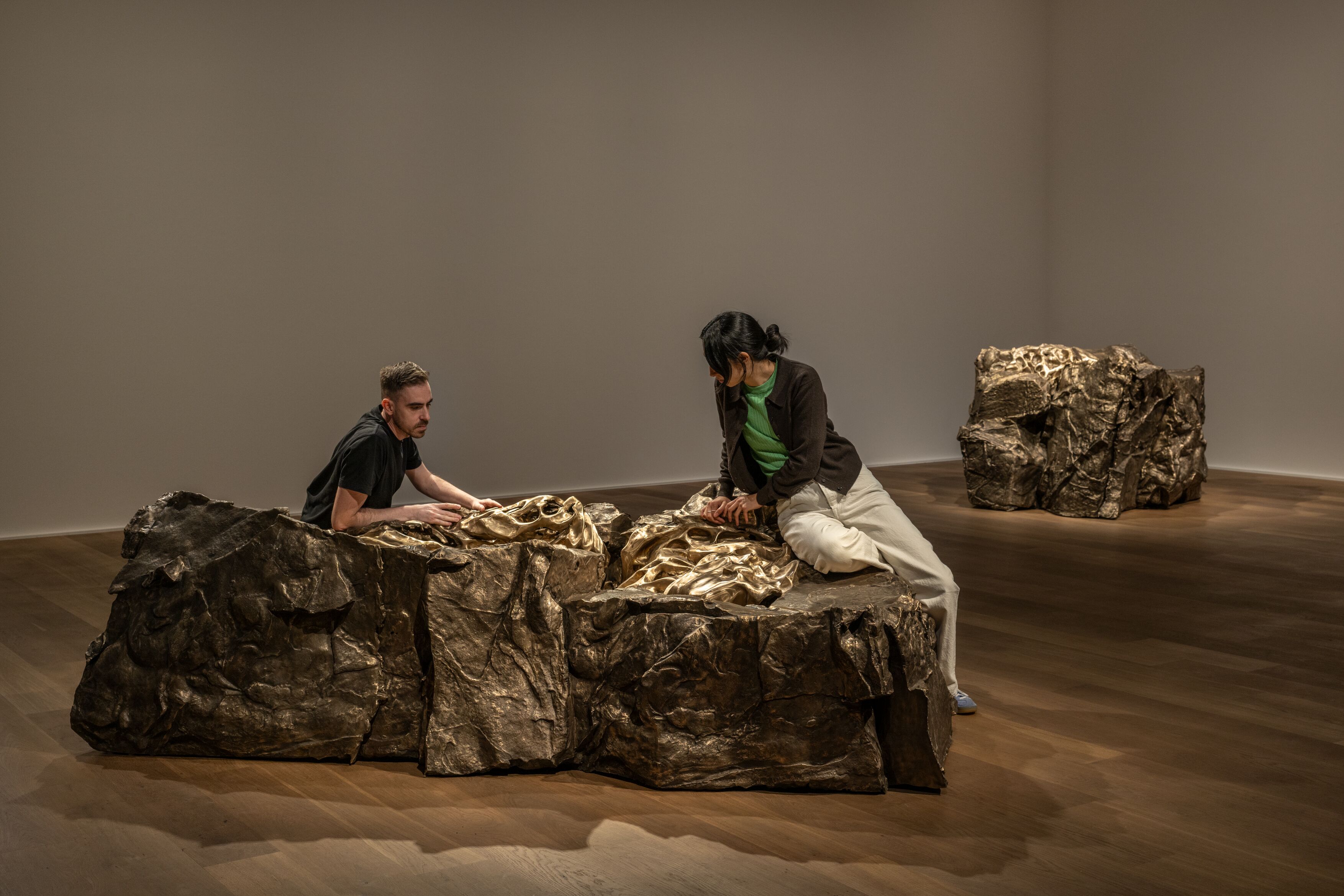
Installation view, ‘Cristina Iglesias. The Shore,’ Hauser & Wirth London, 2025 © Cristina Iglesias, VEGAP, Barcelona, 2025. Photo: Damian Griffiths
How does she make her work?
Cristina Iglesias uses a combination of traditional craft and experimental techniques. She works in bronze, often casting surfaces that imitate textures found in nature, such as rock, eroded stone or porous lunar surfaces. The patinas (surface treatments) give the metals their color and texture; in this exhibition the ‘rock-like lustre’ suggests both meteorite and erosion. Iglesias shapes her work so that water is both part of the form and the experience, its sound, its mirror like surfaces and its movement—flowing, rippling and reflecting—making time perceptible. In drawing on the multiple histories and roles of water, Iglesias harnesses its flow and ripples to explore notions of memory and the past.
Iglesias’ work is also site aware; even when pieces are portable or gallery-based, there is a consideration of light, of the surroundings and the architecture of the space. Some works are site-specific and others draw on geological or natural features in their texture or form.
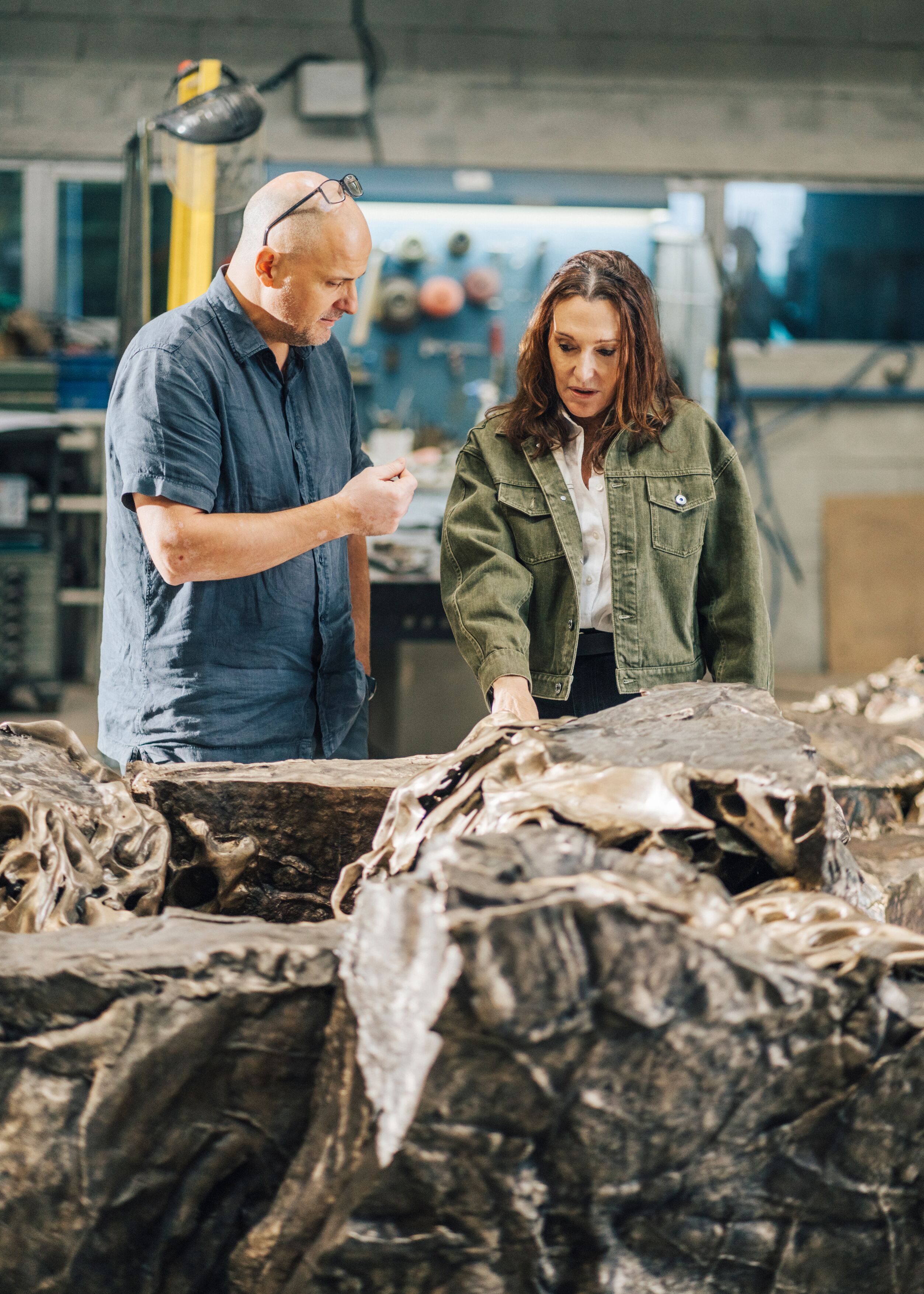
Cristina Iglesias, 2025 © Cristina Iglesias, VEGAP, Barcelona, 2025. Photo: Álex Iturralde
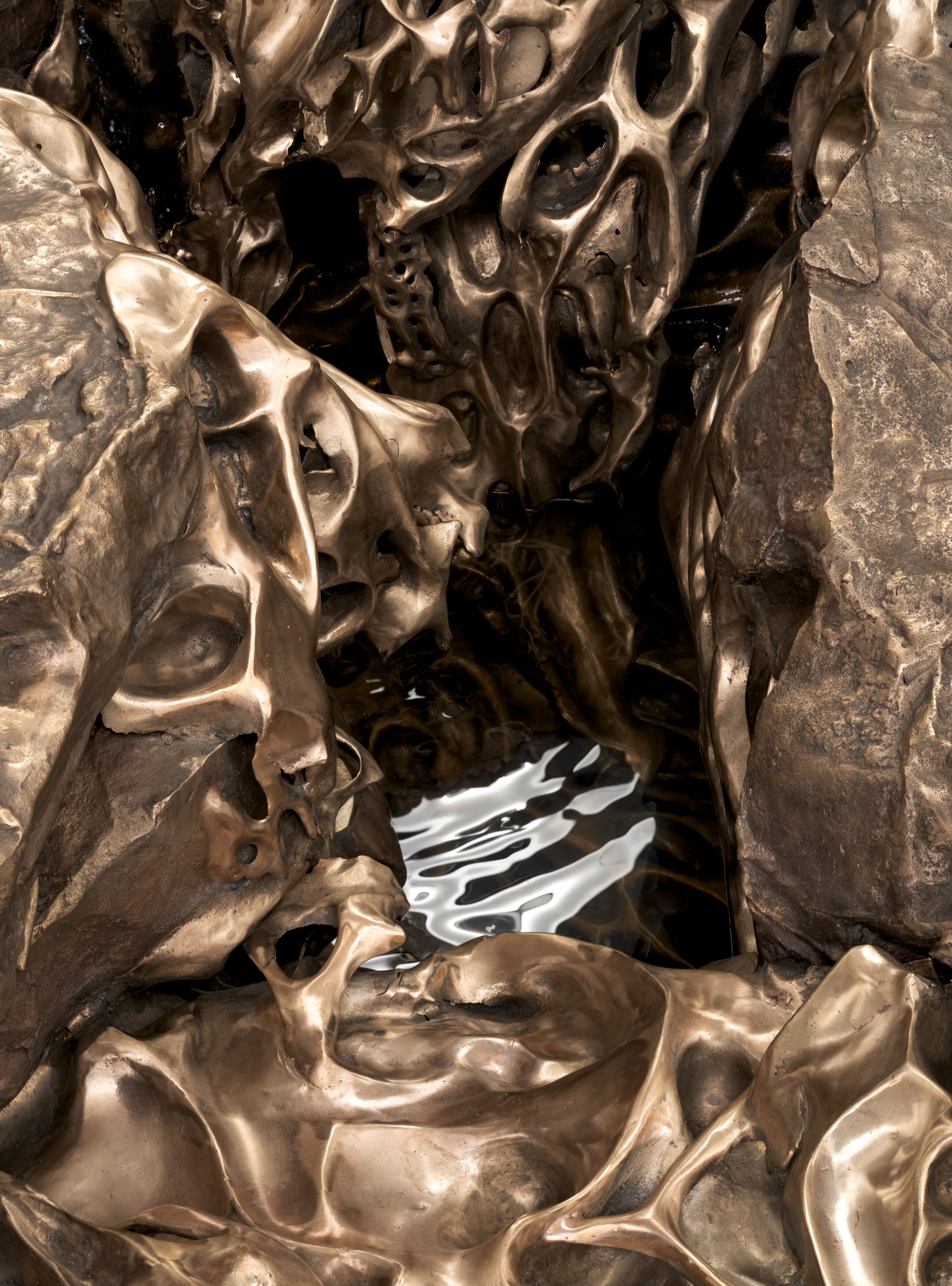
Cristina Iglesias, Littoral (Lunar Meteorite) IV (detail), 2025 © Cristina Iglesias, VEGAP, Barcelona, 2025. Photo: Alex Delfanne
What are the sources of her subject matter?
Iglesias’ subject matter draws from geology (coasts, shores, erosion, geological time), from outer space (meteorites, lunar forms), and from water. These combine to evoke histories of earth and space, passage of time and place, examining how natural forces shape matter, memory or landscape. She also draws from architecture, not just in physical form (walls, shelters, pavilions), but in how spaces affect human experience, such as enclosures, thresholds and transitions. Another source is memory, of past landscapes and histories inscribed in stone, rock or water, of natural change and human interaction with nature.
What are the major themes within the exhibition?
Memory and time
Natural processes, geological forces, lunar presence and water’s movement all hold records of time, and how the shore or coastline is a place where history is visible and constantly changing.
Meeting of earth, water and space
Collision of outer space (meteorites) and Earth; the littoral zone as thresholds, with water as medium that both connects and separates.
Materiality and texture
Contrast between rugged, natural surfaces and polished lustre, porous form, reflections and the interplay between hidden mechanisms and what is revealed.
Perception, environment and place
How the works interact with surroundings (light, reflections, sound), how the exhibition space functions and how architecture or quasi-architectural forms frame experience for the viewer.
Natural versus artificial
Even when metallic, sculpted and designed, Iglesias’ works maintain tension between being manufactured and man-made, as well as being part of natural or organic processes.
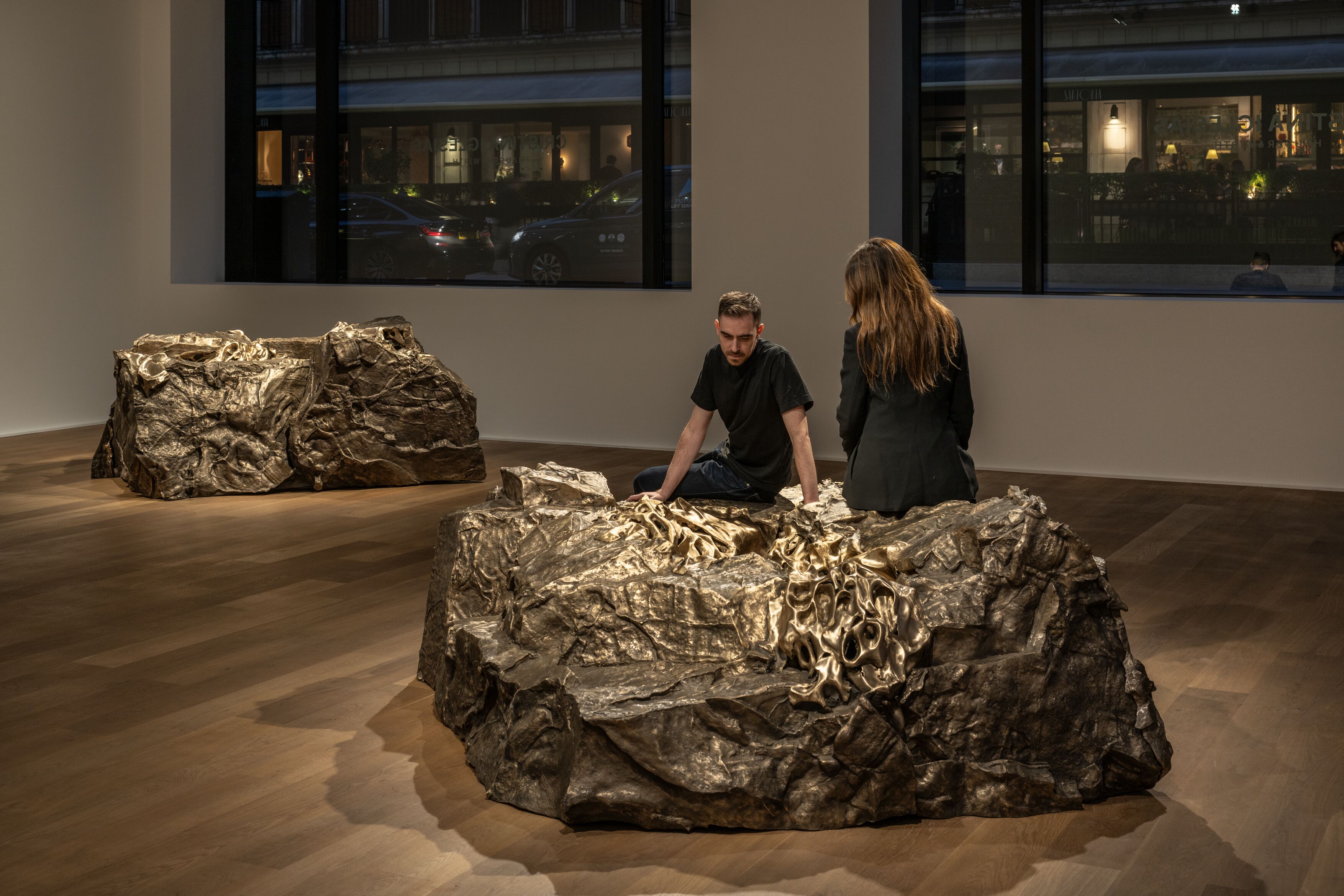
Installation view, ‘Cristina Iglesias. The Shore,’ Hauser & Wirth London, 2025 © Cristina Iglesias, VEGAP, Barcelona, 2025. Photo: Damian Griffiths
What other artists does his work relate to?
Doris Salcedo’s (b. 1958) work explores trauma and memory embedded in material and form. Salcedo’s ‘Shibboleth’ physically ruptures institutional space, like Iglesias’ submerged or semi concealed spaces.
Rachel Whiteread (b. 1963) in the use of casting and negative space, memory, echoing absence or history in form.
Ana Mendieta (1948 – 1985) created site-specific and land-based works. Her ‘Silueta’ series echoes with Iglesias’ concern for land, water, erosion and presence within place.
Andy Goldsworthy’s (b. 1956) use of natural materials, attention to environment, erosion, time and transformation can be compared to that of Iglesias—though his work is more ephemeral.
Lara Favaretto’s (b. 1973) deals with time, ephemerality and transformation—her work often includes mechanized elements systems to activate or animate seemingly static sculptures, echoing Iglesias’ hydraulic systems.
Other Hauser & Wirth artists to consider
Phyllida Barlow’s (1944 – 2023) large scale installation sculptures often transform gallery space, inviting physical movement around and through them. She uses modest or everyday materials, yet her works feel bodily, immersive and engages with presence, scale and materiality—similar concerns to Iglesias.
Louise Bourgeois’ (1911 – 2010) work explores memory, psychological histories, shelter, organic forms and architectural metaphor. Her works have often been about space, about what is hidden versus revealed, about emotional and material textures. Iglesias similarly works with memory, texture and quasi-architectural form.
Jenny Holzer (b. 1950) works with ideas of space, environment, public realm and perception. While Holzer often uses text, projections, light and scale, she also considers viewer interaction, environment and how art changes meaning in different settings to highlight how environment and the viewer affect what an artwork is.
Berlinde De Bruyckere (b. 1964) works with organic, bodily and mythological references. Her fascination with vulnerability, decay and transformation connects to Iglesias’ themes of erosion, memory and geological time.
Rashid Johnson (b. 1977) creates environments filled with living plants, tile, shea butter and other materials that evoke rituals and nature. His immersive installations, combining organic materials and cultural references, share a dialogue with Iglesias’ environmental and elemental themes.
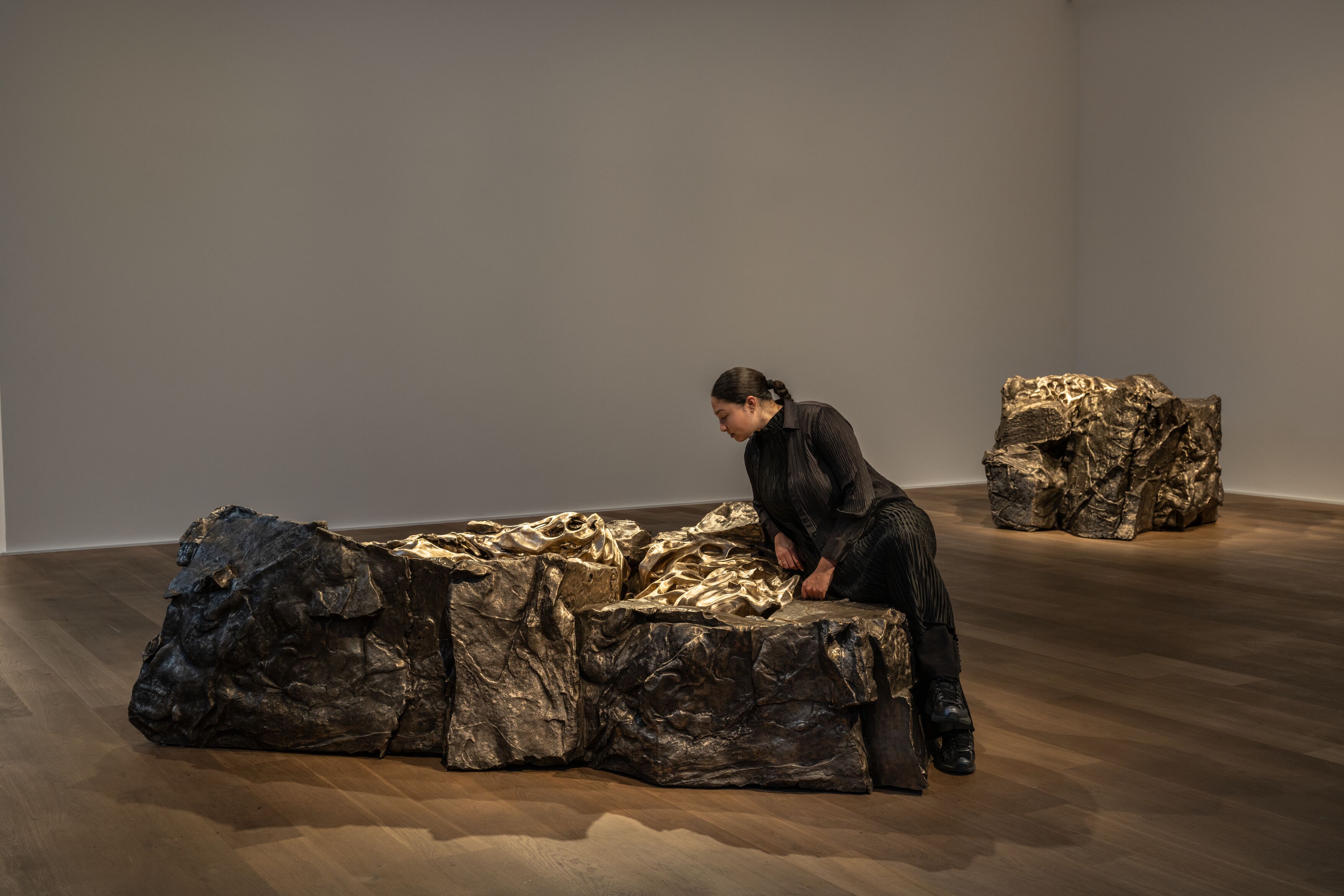
Installation view, ‘Cristina Iglesias. The Shore,’ Hauser & Wirth London, 2025 © Cristina Iglesias, VEGAP, Barcelona, 2025. Photo: Damian Griffiths
Glossary
Geology
The study of the Earth, including rocks, landforms and the processes that shape them over time.
Hydraulic mechanisms
Systems that use water or fluid movement—often hidden in Iglesias’ work—to create motion or flowing effects.
Immersive
A type of art experience where viewers feel physically and emotionally involved, often surrounded or enveloped by the work.
Installation
A type of art that transforms a space and often surrounds or immerses the viewer, rather than being just an object on display.
Interdisciplinary
Combining more than one subject area, like science, architecture, literature and art. Iglesias’ work often does this.
Littoral
The part of land next to or near the shore (e.g., where land meets the sea). Iglesias’ series uses this idea metaphorically.
Memory (in art)
Not just personal memories, but ideas of time passing, history and forgotten stories expressed through materials or forms.
Meteorite
A piece of rock or metal from outer space that has landed on Earth. Iglesias references their form and symbolism.
Patina
The thin surface layer that develops on an object’s surface due to age, wear, chemical action or exposure to the environment.
Quasi-architectural
Artworks that look or feel like buildings or spaces but do not function as real architecture —more suggestive or symbolic.
Reflective surface
A surface that mirrors surroundings or people—like still water or polished metal—used in art to involve the viewer.
Sculpture
A three-dimensional artwork that can be made from materials like stone, metal, glass or even water.
Site-specific
An artwork made for a particular place that responds to its surroundings, history or environment.
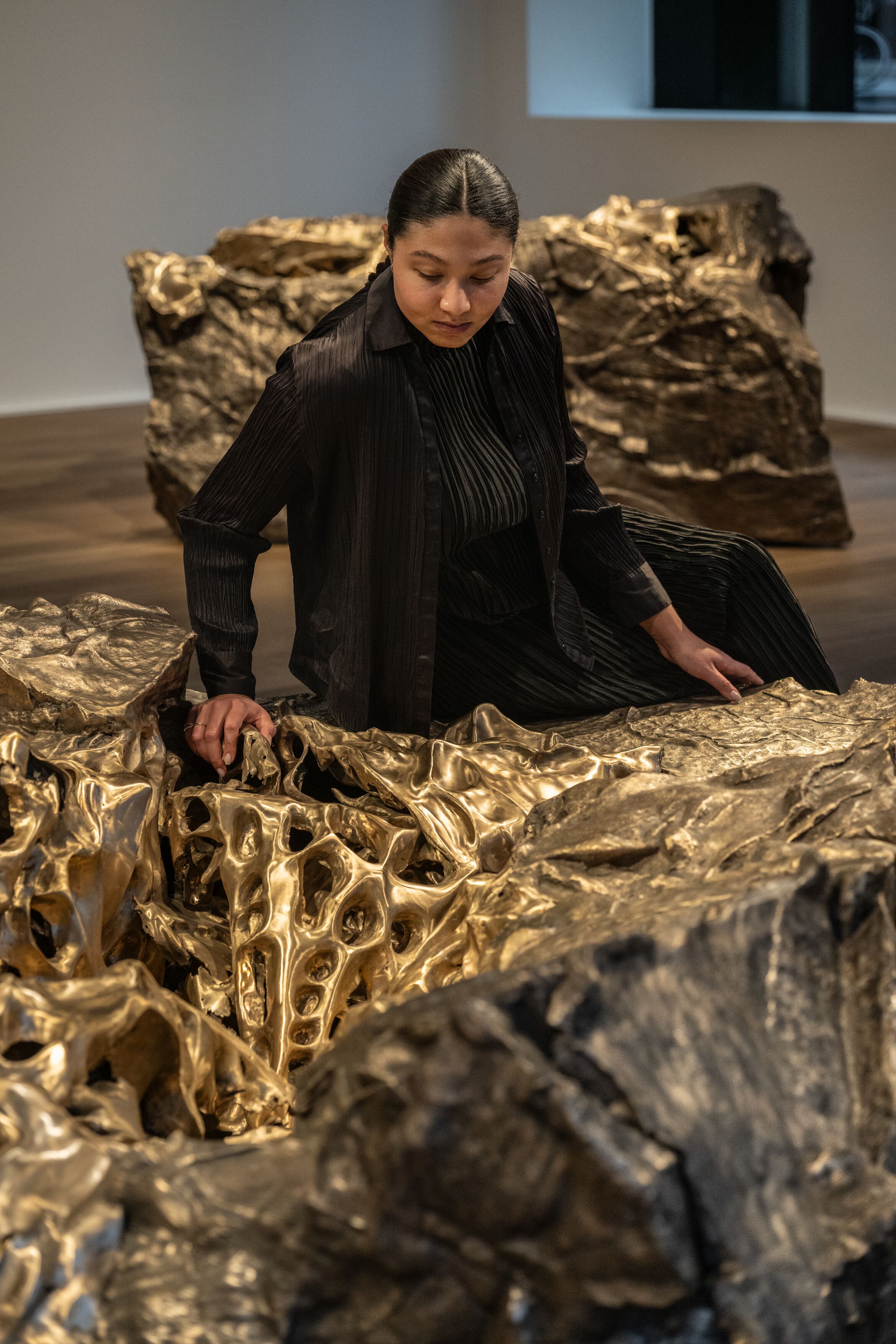
Installation view, ‘Cristina Iglesias. The Shore,’ Hauser & Wirth London, 2025 © Cristina Iglesias, VEGAP, Barcelona, 2025. Photo: Damian Griffiths
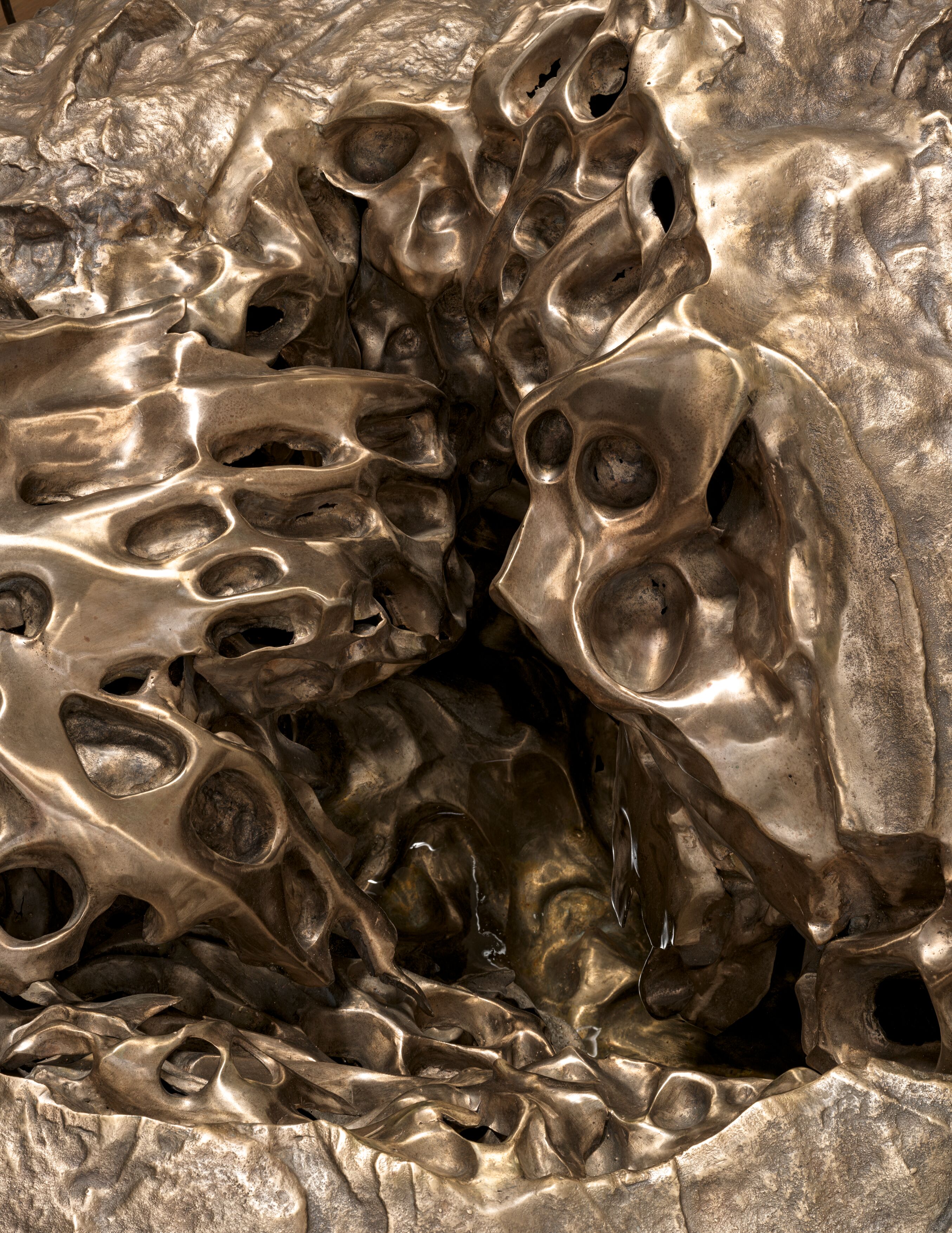
Cristina Iglesias, Littoral (Lunar Meteorite) III (detail), 2025 © Cristina Iglesias, VEGAP, Barcelona, 2025. Photo: Alex Delfanne
Discussion questions
The sculptural forms in Iglesias’ work are often inspired by geology, architecture and nature, such as meteorites, caves, grottos or tidal pools. These forms feel ancient or weathered, yet also artificial and constructed. How does Iglesias blur the boundaries between natural and manmade and how does this tension affect your reading of the work?
Iglesias is deeply interested in the passage of time and in forgotten or hidden histories. Her use of materials like bronze and her references to erosion, water flow and buried forms suggest ideas of memory and transformation. How do the materials and forms in Iglesias’s work evoke ideas of time, memory or history? What do you think she wants us to remember, or to imagine?
Many of Iglesias’ installations are inspired by specific locations or landscapes. Her use of the littoral—the shoreline between land and sea—appears metaphorically as a space of change and encounter. How does place (or the idea of place) influence your interpretation of her work? Could these pieces belong anywhere, or do they feel tied to a specific environment or sense of geography?
Supplementary research
Resources
1 / 10

